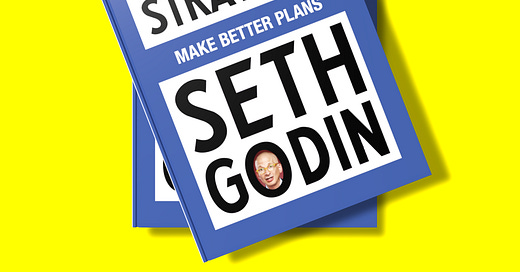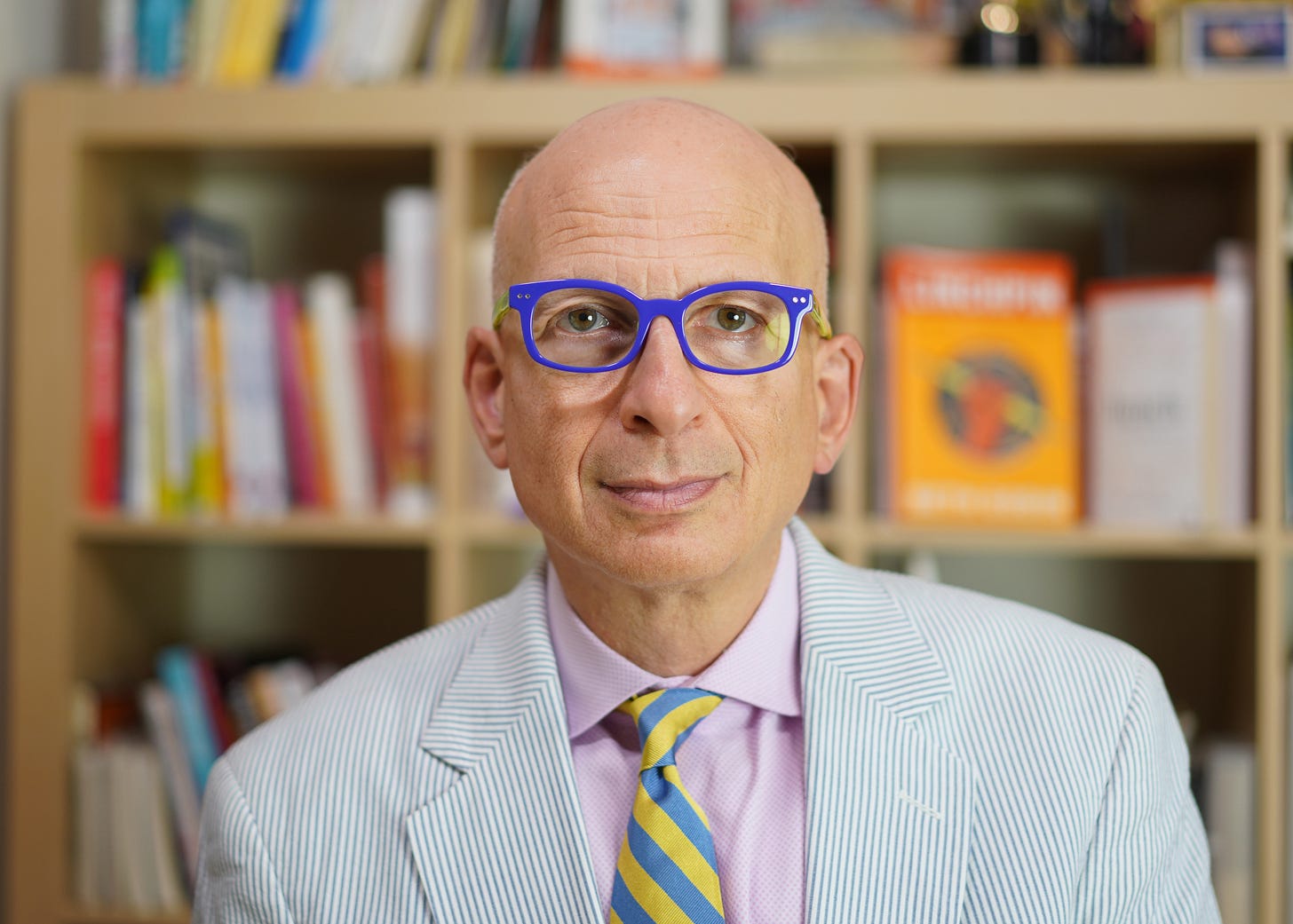This book will change the way you think.
A conversation with Seth Godin, whose book This is Strategy goes on sale today.
Hi, all!
Greetings from the desk/kitchen table of Carly Gorga, CMO and proud employee numero uno of Authors Equity. I've been on this journey since January and have loved almost every second of my time here. That's because I'm learning so. damn. much. Of course from my colleagues, but also from the authors themselves. My favorite teacher so far is the man we're extremely proud to publish today, one of the world's most influential business and strategic thinkers, and an all-around stand-up human: Seth Godin.
I will confess that Seth wasn't on my radar before we started working together, and I'm honestly not sure how I missed him. I'm a strategist and a marketer, and he's the author of 21 internationally bestselling books about strategy and marketing, plus a daily newsletter with more than 2,000,000 subscribers. So, yes, I was late to the party, but boy, has his writing changed my work–and my life.
Seth sees things that others don't; and he has the rare Yoda-like ability to articulate them in a way that's both simple and profound.
Creating tomorrow by repeating yesterday is not a useful way forward.
Every strategy requires choice. And those choices often involve saying “no” to things we could do, but won’t do. (I know all my corporate comrades feel me on this one!)
It’s not easy to persuade someone to want what you want. It’s much more productive to find people who already want to go where you’d like to take them.
People like us do things like this. (Sit with this one for a second.)
See? Simple but profound. And it applies to all facets of life, not just business. So, if you're looking for a spark, if you want to make change for yourself and for others, if you want to make better plans, READ THIS IS STRATEGY. It'll change the way you think and it'll change the way you live. I guarantee it!
And now, a Q&A with the man himself…Mr. Seth Godin.
–Carly
AE Chats: A Conversation with Seth Godin, author of This is Strategy, by JoliAmour DuBose-Morris.
What was going through your mind when you started writing This is Strategy?
Seth Godin: This is a book of philosophy, not tactics or shortcuts. It’s the book to read before you set out to do what most people think of as “work.” Because it doesn’t matter how fast you’re going if you’re headed in the wrong direction.
What’s one big idea you hope people take away from the book?
SG: I needed to create this book because I want to create the conditions for people to talk about these ideas; to work with peers to outline and improve their strategy for making a difference – in business or in life.
You’ve been thinking and writing about marketing and strategy for a long time. What’s the biggest shift you’ve seen in how these work now vs. when you were getting started?
SG: The two biggest shifts are:
A. Everyone at some level is on their own. The idea that you’d have a job that was a career, where the boss told you what to do all day – a job where you’d stay for decades – is now officially absurd.
We have enormous freedom in how we show up in the world, what we consume, what we learn, and what we do next. It makes no sense to follow when it’s more productive to lead.
B. The speed of life has increased a hundredfold. Everything is in fast forward, and it’s easy to get dizzy.
Has writing This is Strategy changed how you approach your work or see the world? Are there any quotes or mantras from the book that you find yourself thinking about a lot?
SG: Every book I write changes me…at least as much as the people who read it.
Thinking deeply about strategy and decisions helped me become more aware of how unintentional I’d been about many choices. And writing about time reminded me about its relentless passage and the options it brings, day after day, moment by moment.
Knowing what you know now, what advice would you give your younger self about building a career and making an impact? Would you have done anything differently?
SG: There are so many dead ends and missed opportunities I could point out. But those failures made me who I became, and I wouldn’t trade them in.
If I was giving advice to someone in their 20s, it would be to live a life of projects. Go start something. Build a community. Make a difference.
Who are other writers and strategists that keep you inspired – or challenge you?
SG: Cory Doctorow, Steve Pressfield, Pema Chödrön, Anil Dash, Gabe Anderson, Saurabh Mithal, Eva Forde, the one and only Carly Gorga (editor’s note: thank you, Seth!), Avaleen Morris, the early work of Neal Stephenson, Patti Smith, Natalie Nixon, Simon Sinek…
What’s something surprising that people might not know about you?
SG: I built the high-efficiency stereo speakers that I listen to, and many days I paddle my homemade canoe on the Hudson River.
This is kind of a silly question, but do you have any unpopular opinions? In general or specific to business, marketing, and strategy?
SG: Aren’t these the kind that matter the most? Unpopular opinions that stand the test of time and become popular. I was kicked out of the Direct Marketing Association for my stand against spam, and permission marketing was considered ridiculous.
The obvious path might not be the right one.







Hello and to Seth.
My only comment is the observation that for someone so apparently open, and forward thinking, why is he not contactable to ‘speak’ to? Too important? A guru one must only listen to? The central thesis (at first glance) is that the idea of careers (or regular employment for up to a working lifetime) is out the window/ old hat/ irrelevant in this age of expansive freedoms of choice/responsibility – is surely not new? In the 1970’s as a school leaver, college student I decided (and told my girlfriend / future wife) I would never follow a career but simply do what interested me for as long as it interested me wherever possible. As a film student I co-produced a short film that won the Don Quixote award at the Cracow (Poland) short film festival. Sometime broke, I had to work at not very exciting jobs (steel tube cutter at a dangerous factory – but amused myself at my machine post reading ‘Platform for Change’ by Stafford Beer (advisor to President Allende of Chile before he was assassinated – a Cybernetics professor who was a close friend of Bucky Fuller (an American you might have heard of) Caught reading by the company bosses they demanded I be sacked on the spot but was saved by my line manager who said, ‘‘But he’s got the highest production figures in the factory!” I went on (late 70’s) to become a news photographer, then cartoonist, then News graphic artist, culminating in 18 years and 22 international awards as graphics editor of The Daily Telegraph London I resigned when new owners took over to pursue another idea: writing and illustrating my own stories, setting up my own publishing company, editing, designing, producing to print-ready, printed in China and sent to a UK warehouse, persuaded 60 indie bookstores to pre-order, sold more copies at a first signing in Waterstones (a chain) than any author in their concurrent book festival – became a favourite in that chain and sold 9,000 copies at £15 (this a is a hardback kids book of 176 pages with 80 illustrations) in four years.
My pseudo-publ. co. was accepted as legit by the Publishers’ Association and the Independent Publishers Guild, receive UK Trade & Industry grants to exhibit at Frankfurt and Bologna Book Fairs, – the book was invited to Hollywood twice, made a Book of the Year by the Lovereading4kids website here in UK, sold to South Korea and China, where sales brought my Paper sales total to 32,000 worldwide. My second book, a Gothic Ghost tale /historical mystery sold as a trade paperback 3,000 at £10 here. Both were stopped in their tracks by a new MD of Waterstones, who banned all-day signings by non-famous authors and included me despite my pleas I had put £140,000-worth through their tills at my signings In parallel to this I was illustrating for publishers (non-fiction) including the Penguin Group, Hachette, Osprey military (catered in the main for American gun enthusiasts (3 series - Weapon, Duel and Raid plus various books including ‘Killing Bin Laden’) – plus 90 issues of a Great Battles series for a Russian partworks (before 2014). Plus illustrating cutaways for major architects herein the UK of historic buildings.
All this is to show that I pursued the concept of move where the interest takes me and never work for an employer but with an employer for as long as mutually beneficial. If not, work for yourself (ie I learned every aspect of the publishing operation from design to marketing in the couple of years before launching my first book. So your advoccacy, while being entirely valid, is not actually new. All it takes (and took for me back then) is a decision to pursue one’s goals / interests / heart? wherever it leads and to hell with the consequences. Cheers. Alan. Your can pore through a couple of my blogs here, if the whim takes you.
https://alangillilandillustration.blogspot.com/2016/11/portfolio-page-one.html
Each blog post is a different illustration type - field.
https://alangilliland.blogspot.com/2024/04/agents-dontcha-luvvy-luvem.html
Each post is a personal reflection of my day’s interest.
I would love to know a little more about the publishing process and what was better going with Author Equity. As far as I can tell as a self published author, this new strategy leverages advantages from using publishers and freedoms only traditionally seen in self publishing.